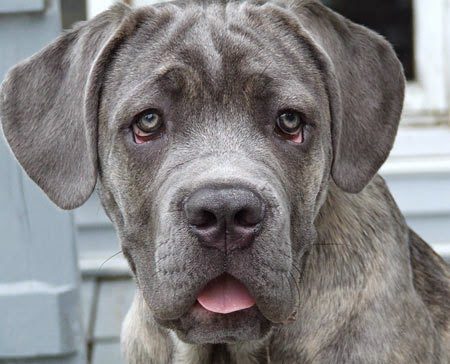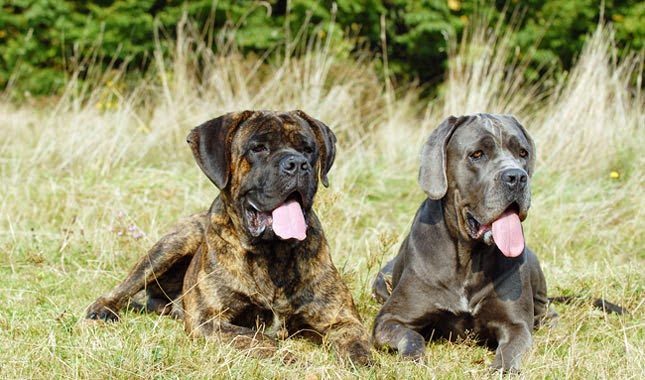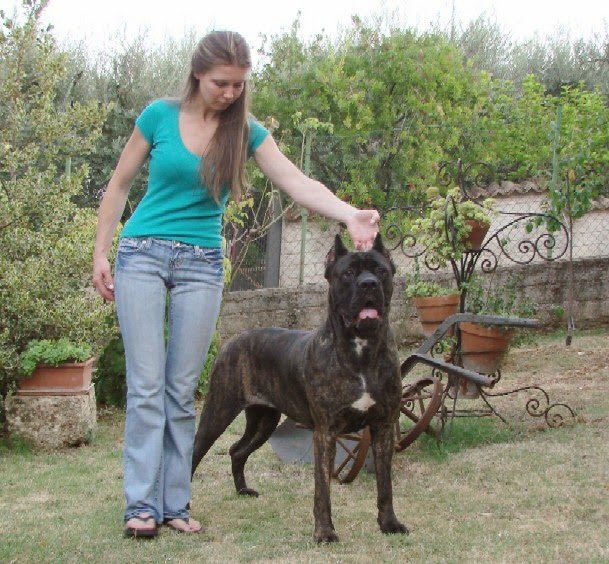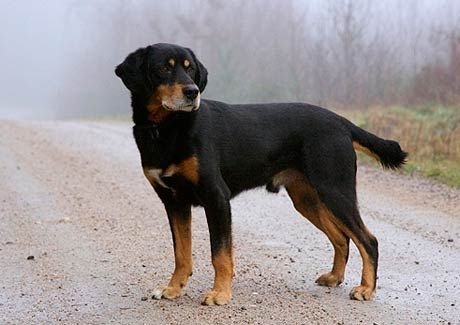Overview
The Cane Corso is a mastiff breed from Italy. He is a complex, powerful dog with special needs. For starters, he is a giant breed, weighing up to 120 pounds. He was created to hunt big game and guard property. The Cane Corso has a massive head, heavy rectangular body, and a short coat in black, gray, fawn, or red.
The Cane Corso is not an appropriate choice for an inexperienced dog owner. First-time dog owners and people who have had only “soft” breeds such as retrievers, spaniels, or toy breeds need not apply. This dog is large, powerful, intelligent, active, and headstrong.
A Cane Corso needs a leader who can guide him with firmness and consistency without using force or cruelty. The Cane Corso loves his family, but he’s not demonstrative about it. He will want to be near you, but he’s not demanding in terms of attention or physical touch.
Early, frequent socialization is essential. Purchase a Cane Corso puppy from a breeder who raises the pups in the home and ensures that they are exposed to many household sights and sounds. Continue socializing your Cane Corso throughout his life by taking him to puppy kindergarten class, introducing him to friends and neighbors, and planning outings to local shops and businesses. This is the only way he can learn to be discriminating between what is normal and what is truly a threat.
That said, no amount of socialization will make him friendly toward people other than his family. The Cane Corso is first and foremost a guard dog, and he takes his responsibilities seriously.
Begin training as soon as you bring your Cane Corso puppy home, while he is still at a manageable size. Institute a nothing-in-life-is-free program, requiring puppies to “work” for everything they get by performing a command before receiving meals, toys, treats, or play. It’s always a good idea to take a Cane Corso to puppy kindergarten followed by basic obedience class, especially if you are working with a trainer who understands the Cane Corso mindset.
The Cane Corso has a moderate activity level and needs a job to do, which can be anything from being your on-leash walking companion to daily training activities. Expect to walk or jog him at least a mile daily, in addition to 20 minutes or so of training practice. He will not be satisfied to lie around and do nothing all the time.
He must also be prevented from chasing and killing cats or small dogs belonging to the neighbors. The Cane Corso has a high prey drive and a territorial nature, so he needs a strong, solid fence at least six feet high to keep him on his own property. An underground electronic fence is never appropriate for this breed.
Like any dog, Cane Corso puppies are inveterate chewers and because of their size can do a whole lot of damage. Don’t give them the run of the house until they’ve reached trustworthy maturity. And keep your Cane Corso puppy busy with training, play and socialization experiences. A bored Cane Corso is a destructive Cane Corso.
The Cane Corso should spend plenty of time with his family. Chaining a Cane Corso out in the yard and giving him little or no attention is not only cruel, it can also lead to aggression and destructive behavior.
The Cane Corso has a smooth coat that sheds. Brush him at least once a week to remove dead hair and keep the skin and coat healthy. Clean the ears and trim the nails as needed, and bathe the Cane Corso on the rare occasions that he’s dirty.
Other Quick Facts:
- Despite a multicentury legacy, the Cane Corso nearly went extinct during World War II.
- The Cane Corso is a fiercely intelligent animal and requires an equally savvy owner.
UKC group: Guardian Dog group
Average lifespan: 10 – 12 years
Average size: 90 – 110 pounds
Coat appearance: Waterproof, shiny, short and dense, similar to a cow
Coloration: Black, various to all shades of gray, fawn, red and brindle
Hypoallergenic: No
Other identifiers: Medium-sized but large-boned and strong muscular body; thick skin; broad muzzle; muscular jaw; black nose; cropped or chin-length ears; long legs; black paws and nails
Possible alterations: May have pink nose, fringed or longer coat.
Comparable Breeds: Bullmastiff, Rottweiler
History
The Cane Corso is a descendant of the canis pugnax, dogs used by the Romans in warfare. Its name derives from cane da corso, an old term for those catch dogs used in rural activities (for cattle and swine; boar hunting, and bear fighting) as distinct from cane da camera which indicates the catch dog kept as a bodyguard. In the recent past, its distribution was limited to some districts of Southern Italy, especially in Basilicata, Campania and Puglia.
The Cane Corso is a catch dog used with cattle and swine, and also in wild boar and cougar hunters. It is also used by night watchmen, keepers, and, in the past, by carters as a drover. In the more distant past this breed was common all over Italy as an ample iconography and historiography testify.
The American Kennel Club first recognized the Cane Corso in 2010. The popularity of the breed continues to grow, ranking in 50th place in the United States in 2013, a jump from 60th place in 2012.
Temperament and Personality
The Cane Corso is a naturally strong-willed dog with a dominating personality. Those characteristics are what make him an exceptional protector of his family and home. However, his natural tendency to take charge can be troublesome to an owner who is unable to establish his or her role as pack leader and control this behavior. While the Cane Corso is loving and affectionate with his family, including children, he will try to rule the roost. Anyone considering this breed must be prepared to set boundaries with confidence because this dog will surely test them.
The Cane Corso is highly intelligent and athletic, and he needs plenty of activity to keep him fit physically and mentally. Take him jogging or on strenuous hikes to help him burn off his energy.
The Cane Corso may be best suited to a family with older children (age 9 and up) rather than a family with babies and toddlers due to his large size and the time and effort required to closely supervise interactions between the dog and young children.
Start training your puppy the day you bring him home. Even at eight weeks old, he is capable of soaking up everything you can teach him. Don’t wait until he is 6 months old to begin training or you will have a more headstrong dog to deal with. If possible, get him into puppy kindergarten class by the time he is 10 to 12 weeks old, and socialize, socialize, socialize. However, be aware that many puppy training classes require certain vaccines (like kennel cough) to be up to date, and many veterinarians recommend limited exposure to other dogs and public places until puppy vaccines (including rabies, distemper and parvovirus) have been completed. In lieu of formal training, you can begin training your puppy at home and socializing him among family and friends until puppy vaccines are completed.
Don’t let him get away with behaviors such as growling or snapping when he is touched or moved, or when he doesn’t want to go outside or go in a certain direction on leash. Nor should he be allowed to behave that way when someone gets too close to his toys or food. Mounting family members is also inappropriate. Quick, decisive action is needed to reassert your authority as pack leader in such cases. To prevent these types of behaviors in the first place, work closely with a trainer or behaviorist who understands the mindset of guardian breeds.
Ask yourself why you are interested in this breed. Talk with a reputable, experienced Cane Corso breeder. Describe exactly what you’re looking for in a dog and ask for assistance in selecting a puppy. Breeders see the puppies daily and can make uncannily accurate recommendations once they know something about your lifestyle and personality. Choose a puppy whose parents have nice personalities and who has been well socialized by the breeder from birth.
Health
Life expectancy for a Cane Corso is 10 to 11 years. As a large and robust dog, it has the typical bone and joint problems of giant breeds. These can include hip dysplasia and degenerative joint disease. Providing proper nutrition and preventing obesity from occurring can help reduce the risk of degenerative joint disease. Hip dysplasia is more genetically based.
Cane Corso’s are also prone to common eye defects, such as entropion, ectropion, and glandular hypertrophy, or “Cherry eye.”
Living Conditions
The Cane Corso will do okay in an apartment if it gets enough exercise. They will be content to live outdoors provided they have adequate shelter.
Exercise
This very athletic breed needs a lot of regular exercise. They make excellent jogging companions, and if not jogged daily, should be taken on at least one long, brisk daily walk.
Care
The Cane Corso is quite simple to care for. As a short haired breed, it does not require much grooming; just a bath and a brush now and then. Shedding is minimal. It is also flexible when it comes to living arrangements as the Cane Corso can settle just as happily into apartment dwelling as outdoor living. If left outdoors, adequate shelter needs to be provided. If dwelling in an apartment, owners need to make sure to provide enough daily exercise. The Cane Corso can make excellent jogging companions, but for daily exercise needs it need at least one long, brisk walk.
Grooming
Grooming the Cane Corso is quite easy due to his short coat, though his large size means it’s a big job. Brush his sleek coat with a natural bristle brush or mitt once a week. Use coat conditioner/polish to brighten the sheen. Bathe him every three months (or when he’s dirty) using a mild shampoo.
The rest is basic care. Check his ears every week and clean if needed. Trim his toenails regularly, usually once a month, and brush his teeth regularly using a soft toothbrush and doggie toothpaste to keep his teeth and gums healthy. It is essential to introduce grooming to the Cane Corso when he is very young so he learns to accept the handling and fuss peacefully.
Is this breed right for you?
Active, the strong Cane Corso requires a lot of exercise. An excellent family dog, it gets along well with children but has a serious instinct to chase other animals, including cats. While it does well living in an apartment if it receives adequate fitness, the Cane Corso would also be satisfied living outdoors. Loyal to its owner and extremely gentle, it is best that it has an owner that is well-versed in the breed and is stern in its training. Typically, it is best that the Cane Corso is taught to be submissive to its owner and family. In addition, this breed should be socialized young to avoid its protective instinct kicking in with invited guests. Requiring only an occasional brush, the Cane Corso is very easy to groom and only lightly sheds. However, it is known for drooling, especially when overheated.
Did You Know?
The Cane Corso is also known as Dogo di Puglia, which means “dog of Puglia.”
A dream day-in-the-life
A simple breed, it does not require much to make the Cane Corso happy. An affectionate dog, it will be happy to be surrounded by its family throughout the entire day. Going for a quick walk or run, it is likely to guard the home while keeping on the trail of its owner. Around the home, it will be docile and go nearly unnoticed, until it gets into bed with its owner at night








